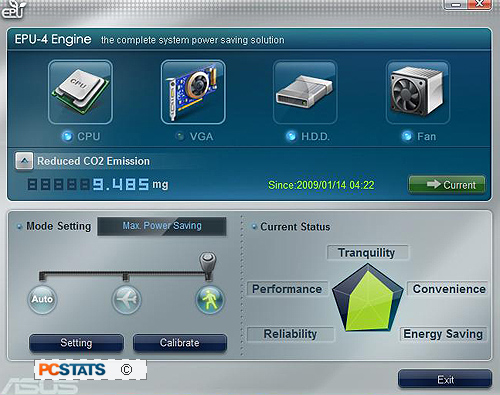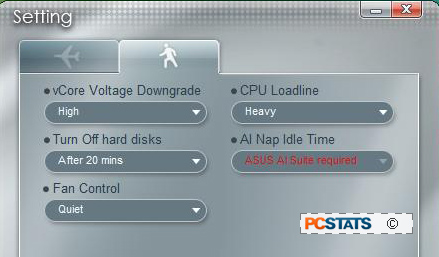Here's how the motherboard stacks up in real life against a
couple different motherboards. We have no way of directly measuring motherboard
power draw, so PCSTATS measures total system power draw and compares that in
CPU-loaded (max value recorded in Prime95) and idle states (at Windows Vista
desktop). An Extech 380803 AC Power Analyzer and A-PFC compliant PC Power and Cooling 750W power supply were used for
these tests.
 System Power Draw Tests: (PCPower 750W
PSU) System Power Draw Tests: (PCPower 750W
PSU) |
| Desktop Idle (W) |
Watts |
Ranking |
| Intel DG45ID (Intel G45 200/800 C2D
E6750 Onboard G45 ) |
68 |
   |
 Asus P5Q-EM (Intel G45 200/800 C2D E6750 GF 8800GTS
320MB) Asus P5Q-EM (Intel G45 200/800 C2D E6750 GF 8800GTS
320MB) |
131 |
   |
 Asus P5Q-EM (Intel G45 200/800 C2D E6750 Onboard G45
) Asus P5Q-EM (Intel G45 200/800 C2D E6750 Onboard G45
) |
72 |
   |
| Foxconn A7DA-S (AMD 790GX 200/800 AM2
X2 5000+ GF 8800GTS 320MB) |
131 |
   |
| Foxconn A7DA-S (AMD 790GX 200/800 AM2
X2 5000+ onboard HD 3300 video) |
61 |
   |
| Biostar Tpower N750 (NF 750a 200/800
AM2 X2 5000+ GF 8800GTS 320MB) |
110 |
   |
| Biostar Tpower N750 (NF 750a 200/800
AM2 X2 5000+ onboard nF 750a video) |
45.4 |
   |
| Prime95 Stressed (W) |
Watts |
Ranking |
| Intel DG45ID (Intel G45 200/800 C2D
E6750 Onboard G45 ) |
121 |
   |
 Asus P5Q-EM (Intel G45 200/800 C2D E6750 GF 8800GTS
320MB) Asus P5Q-EM (Intel G45 200/800 C2D E6750 GF 8800GTS
320MB) |
224 |
   |
 Asus P5Q-EM (Intel G45 200/800 C2D E6750 Onboard G45
) Asus P5Q-EM (Intel G45 200/800 C2D E6750 Onboard G45
) |
122 |
   |
| Foxconn A7DA-S (AMD 790GX 200/800 AM2
X2 5000+ GF 8800GTS 320MB) |
192 |
   |
| Foxconn A7DA-S (AMD 790GX 200/800 AM2
X2 5000+ onboard HD 3300 video) |
121 |
   |
| Biostar Tpower N750 (NF 750a 200/800
AM2 X2 5000+ GF 8800GTS 320MB) |
187 |
   |
| Biostar Tpower N750 (NF 750a 200/800
AM2 X2 5000+ onboard nF 750a video) |
127 |
   |
| 3DM06 IGP Stressed (W): |
Watts |
Ranking |
| Intel DG45ID (Intel G45 200/800 C2D
E6750 Onboard G45 ) |
115 |
   |
 Asus P5Q-EM (Intel G45 200/800 C2D E6750 GF 8800GTS
320MB) Asus P5Q-EM (Intel G45 200/800 C2D E6750 GF 8800GTS
320MB) |
182 |
   |
 Asus
P5Q-EM (Intel G45 200/800 C2D E6750 Onboard G45 ) Asus
P5Q-EM (Intel G45 200/800 C2D E6750 Onboard G45 ) |
119 |
   |
| Foxconn A7DA-S
(AMD 790GX 200/800 AM2 X2 5000+ GF 8800GTS 320MB) |
223 |
   |
| Foxconn A7DA-S
(AMD 790GX 200/800 AM2 X2 5000+ onboard HD 3300 video) |
124 |
   |
| Biostar Tpower
N750 (NF 750a 200/800 AM2 X2 5000+ GF 8800GTS 320MB) |
226 |
   |
| Biostar Tpower
N750 (NF 750a 200/800 AM2 X2 5000+ onboard nF 750a video) |
118 |
   | |
The Asus P5Q-EM's power draw at idle
is highest amongst the integrated motherboards tested, although once the system is stressed the power
drawn falls into line.
Asus' Energy Processing Unit (EPU) is built into the
Asus P5Q-EM motherboard, and what the EPU does is dynamically alter the amount
of power phases the motherboard uses depending on usage and system load. PCSTATS
tested the EPU along with is accompanying software.

The EPU software isn't quite as helpful or as
informative as the Dynamic Energy Saver software found with the Gigabyte EP45-DS4
motherboard. Here we have
an option to switch between power saving mode and performance mode, or
place the entire Asus P5Q-EM system on auto. The amount of power saved
isn't reported back to the user except in the cryptic form of the amount of
CO2 emissions reduced, which in turn assumes your computer is powered by coal. Give
us actual wattage used! Display wattage savings over time!

This sub-menu is a little more interesting,
and can be used to set manual voltage throttling limits on the CPU. This will have a
direct impact on system performance, but does save quite a bit of wattage at
its most extreme settings (note Asus EPU will throttle CPU clock speed to save
power). Unfortunately there's still no direct display of the actual numbers,
so it's difficult to know how much of a voltage downgrade "high" is compared to
"medium".
Finally, PCSTATS plugged the P5Q-EM in, turned on the EPU, and
re-ran our power draw benchmark tests.
| Energy Saving - Total System Power
Draw |
| Motherboard State: |
Power Draw: |
w/h ASUS EPU: |
Approx. Power Saved: |
| Desktop Idle |
72 W |
68 W |
4
W |
| Prime 95 Stressed |
122 W |
117 W |
5
W |
| IGP 3DMark06 Stressed |
119 W |
119 W |
0 W | |
The EPU isn't doing
a whole lot here to modify the power being consumed by the Asus
P5Q-EM motherboard - saving 5 watts at stressed isn't particularly impressive. Turning
on the EPU for idle power saving can make for some power savings over a
long term period. Over the lifetime of a motherboard's use, shaving off
even a few watts overall from a system that's always on can equate to some
money saved off the electricity bill.
Okay, on to the
highlights of the Asus P5Q-EM motherboard.
